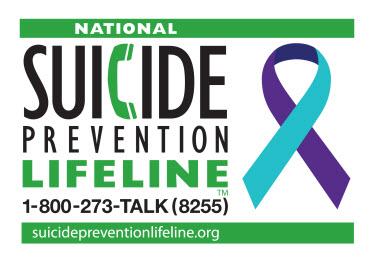About Suicide
What is suicide?
- Suicide ideation - Thoughts of engaging in suicide-related behavior.
- Suicide attempt - A nonfatal self-directed potentially injurious behavior with any intent to die as a result of the behavior. A suicide attempt may or may not result in injury.
- Suicide - Death caused by self-directed injurious behavior with any intent to die as a result of the behavior.
- Suicide Key Terms Explained - Nomenclature-Self-Directed Violence Classification System
Source: U.S. Department of Health and Human Services (HHS) Office of the Surgeon General and National Action Alliance for Suicide Prevention. 2012 National Strategy for Suicide Prevention: Goals and Objectives for Action. Washington, DC: HHS, September 2012.
Spread the word, language matters
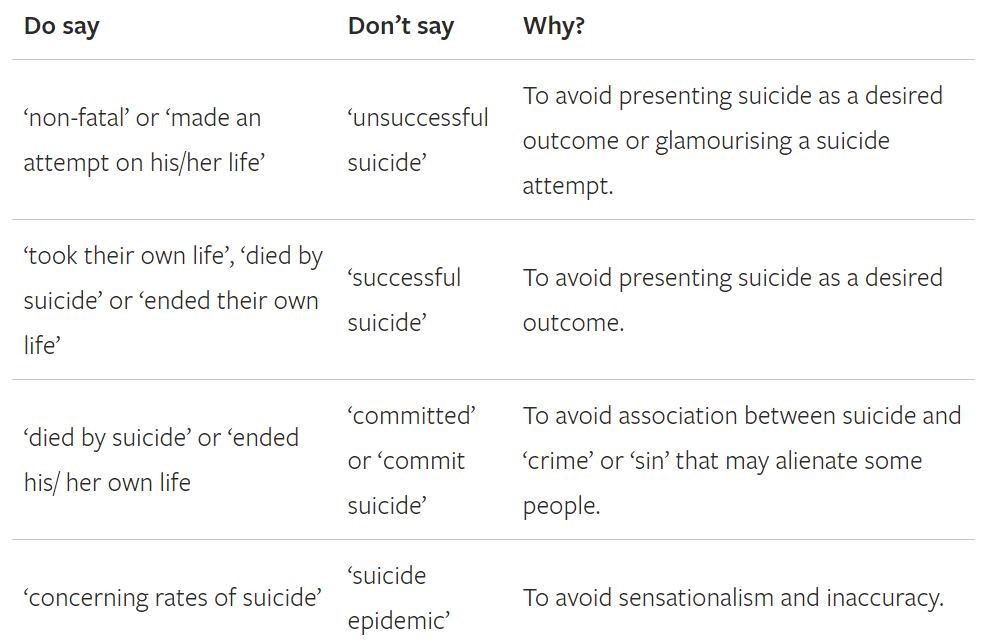
Source: Retrieved from: Language and suicide | Everymind .
Suicide Data
For more information on Florida suicide data, initiatives, and suicide prevention recommendations please see the Suicide Prevention Coordinating Council 2021 Annual Report.
In 2019, Florida lost 3,465 lives to suicide, resulting in a rate of 14.50 per 100,000 individuals (Page 15, Figure 1). This rate was higher than the 2019 national rate of 13.93 per 100,000 individuals. The number of suicide deaths in 2019 decreased by 2.86 percent from 2018. Since 2015, the Florida suicide rate has remained higher than the average national rate, except in 2017 when the rate was slightly below that of the national rate (Figure 1).
Data indicates 3,113 individuals died by suicide in 2020 demonstrating a 10 percent decrease in the number of suicide deaths from 2019 to 2020. In 2020, the suicide death rate was 13.1 per 100,000 individuals, the lowest rate in over a decade and lower than the national rate of 13.5 per 100,000 individuals (Figure 1).
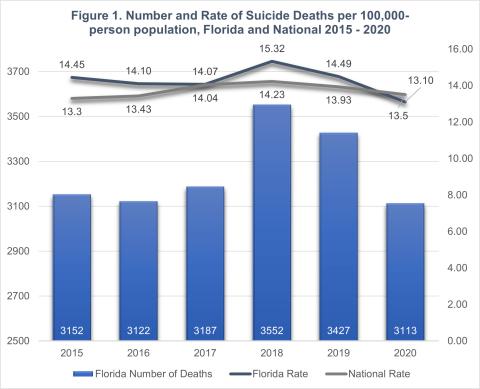
Data Sources: Centers for Disease Control and Prevention National Center for Injury Prevention and Control (2021) Web-based Injury Statistics Query and Reporting System (WISQARS); Florida Department of Health Bureau of Vital Statistics.
The age-adjusted rate of suicide death varies by county across the state. In 2020, Union County had the highest rate, with a rate of 36.6 per 100,000 individuals, followed by Holmes (35.1 per 100,000 individuals), Putnam (31.6 per 100,000 individuals) and Hamilton (31.1 per 100,000 individuals; Figure 2) counties. Lafayette and Franklin counties had the lowest rate with no suicide deaths occurring in 2020, followed by Hardee County with a rate of 6.2 per 100,000 individuals. Most counties have a suicide rate less than 20 per 100,000 individuals.
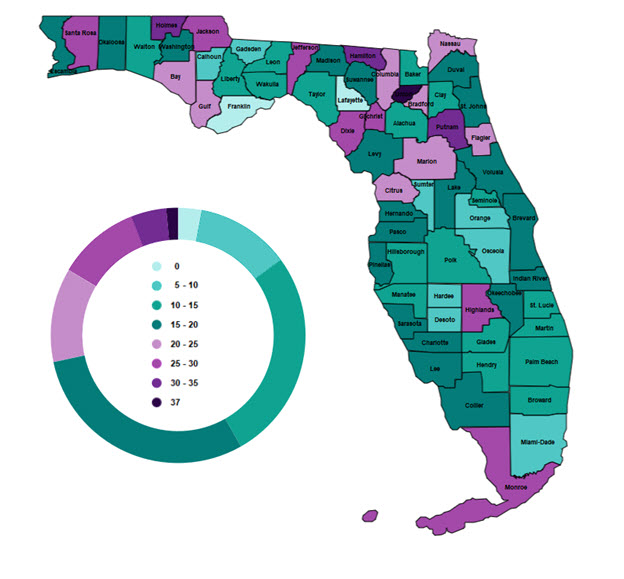
Data Sources: Florida Department of Health Bureau of Vital Statistics.
The trajectory of suicide death rate over the past five years is varied. The suicide death rate was highest in those aged 75 or older in 2020. Importantly, between 2018 and 2019, those aged 10 – 14, 15 – 19, 20 – 24, and 25 – 34 saw increases in their rates (Figure 3).
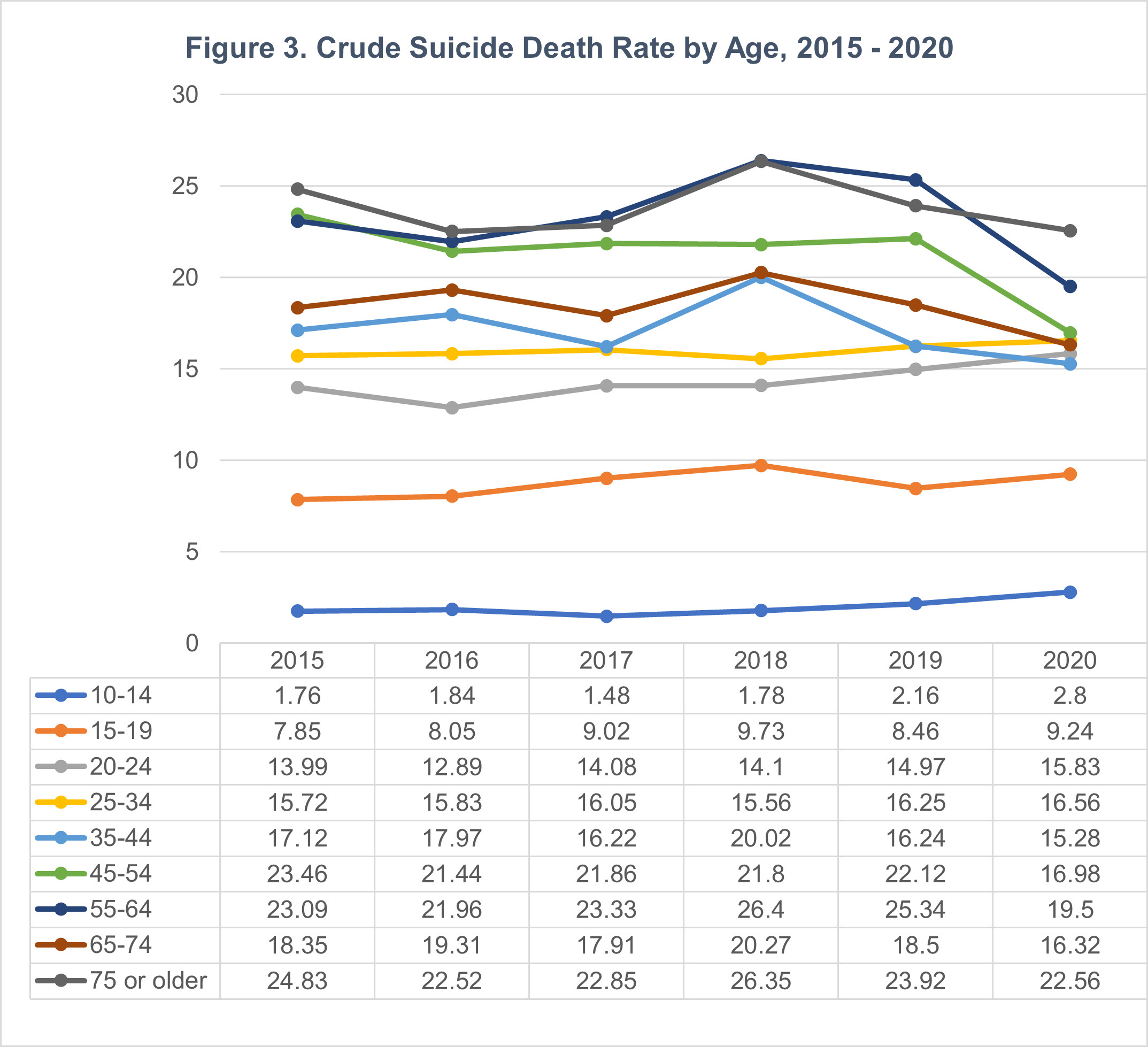
Data Sources: Florida Department of Health Bureau of Vital Statistics.
Floridians in the oldest age group continue to die by suicide at the highest rate followed by Floridians in middle life. Importantly, those aged 45 – 54 and 55 – 64 saw a 28 percent and 4 percent decrease in suicide deaths in 2020 compared to 2015. The following table (Table 2) provides an overview of the percent change from 2015 to 2020 by age group.
Table 1. Suicide Death Count and Percent Change by Age Group, 2015 and 2020
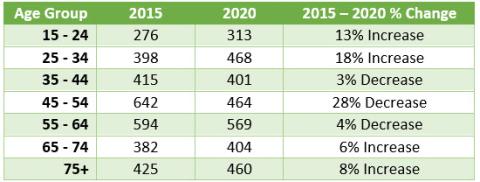
Data Sources: Florida Department of Health Bureau of Vital Statistics.
Figure 4. provides an overview of the suicide death count by age group from 2015 – 2020. The suicide death count has steadily increased for those aged 15 – 24 and 25 – 34 (Figure 4).
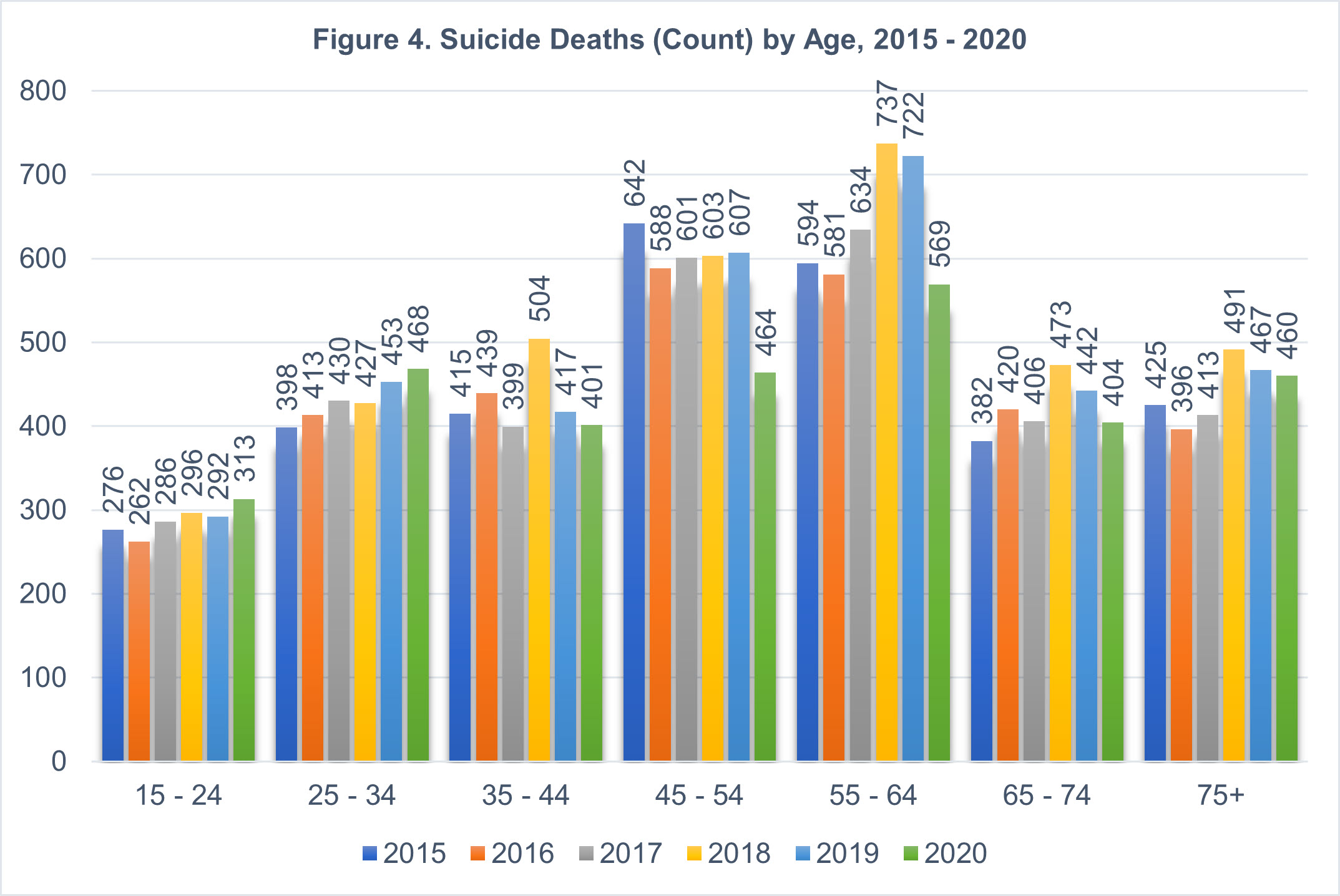
Data Sources: Florida Department of Health Bureau of Vital Statistics. Note: Age group 5 – 14 was removed to maintain privacy since it had fewer than 50 deaths across all years. Range of deaths from 2015 – 2020 for those aged 5 – 14 was 17 – 34, with an average death count across all five years of 24.
Floridian males have more than three times the rate of suicide deaths compared to females. In 2020, the rate of suicide death for males was 20.7 per 100,000 males compared to 6.0 per 100,000 females (Figure 5). Additionally, females have seen a slight decrease in the 2020 rate compared to 2015 (6.8 per 100,000 females). Males have also seen a decrease in 2020 compared to 2015 (22.8 per 100,000 males). Overall, these rates have remained relatively stable from 2015 to 2020 (Figure 5).
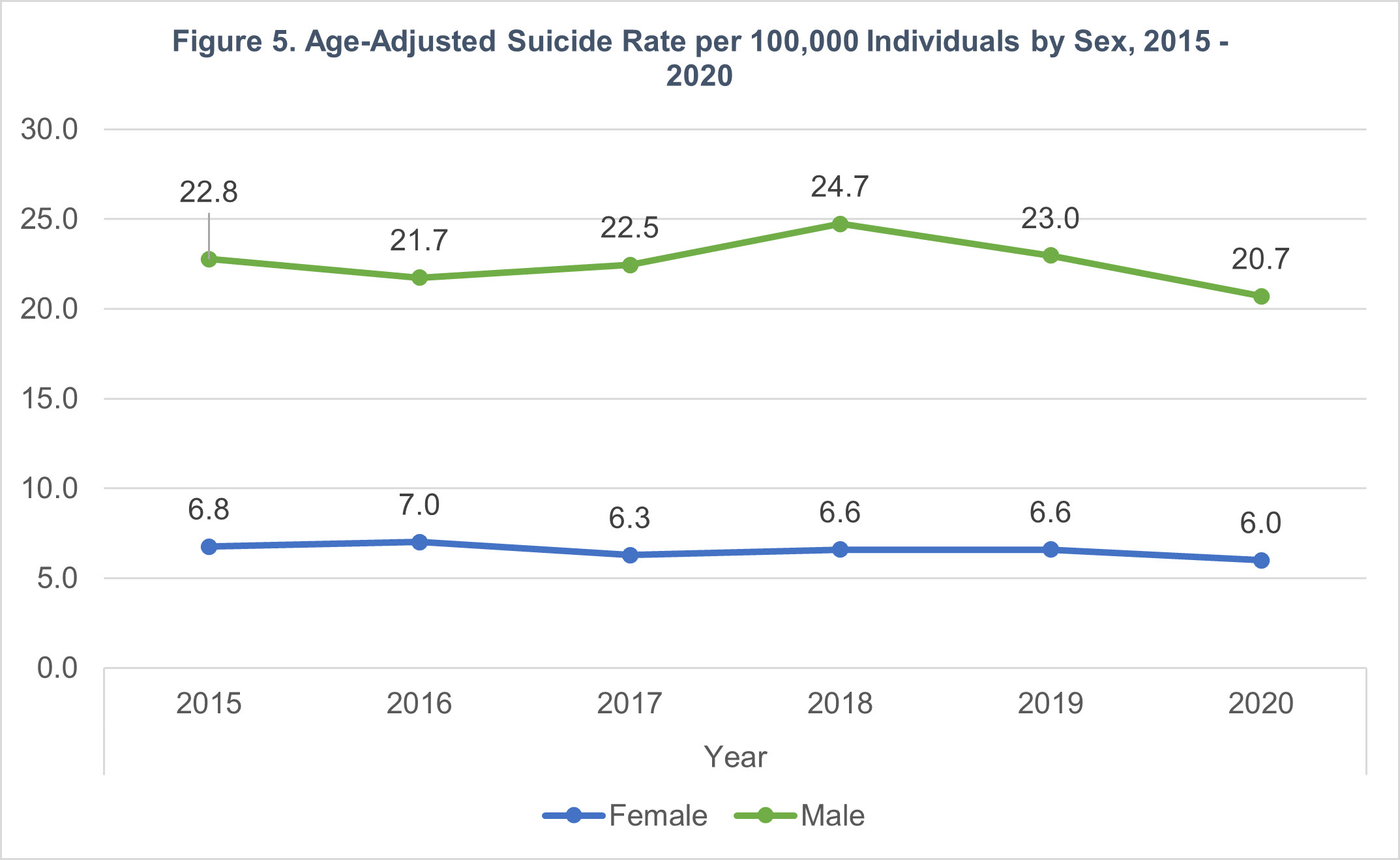
Data Sources: Florida Department of Health Bureau of Vital Statistics.
In 2020, firearms were used in the majority of suicide deaths across the state and all age groups, accounting for 55 percent of deaths. Suffocation accounted for the second most at 23 percent, followed by poisoning at 14 percent and other at 8 percent (Figure 6). The proportion of methods used in suicide deaths varied by age group, however, firearms still accounted for the most suicide deaths within each age group, followed by suffocation, poisoning, and other methods (Figures 7-13).
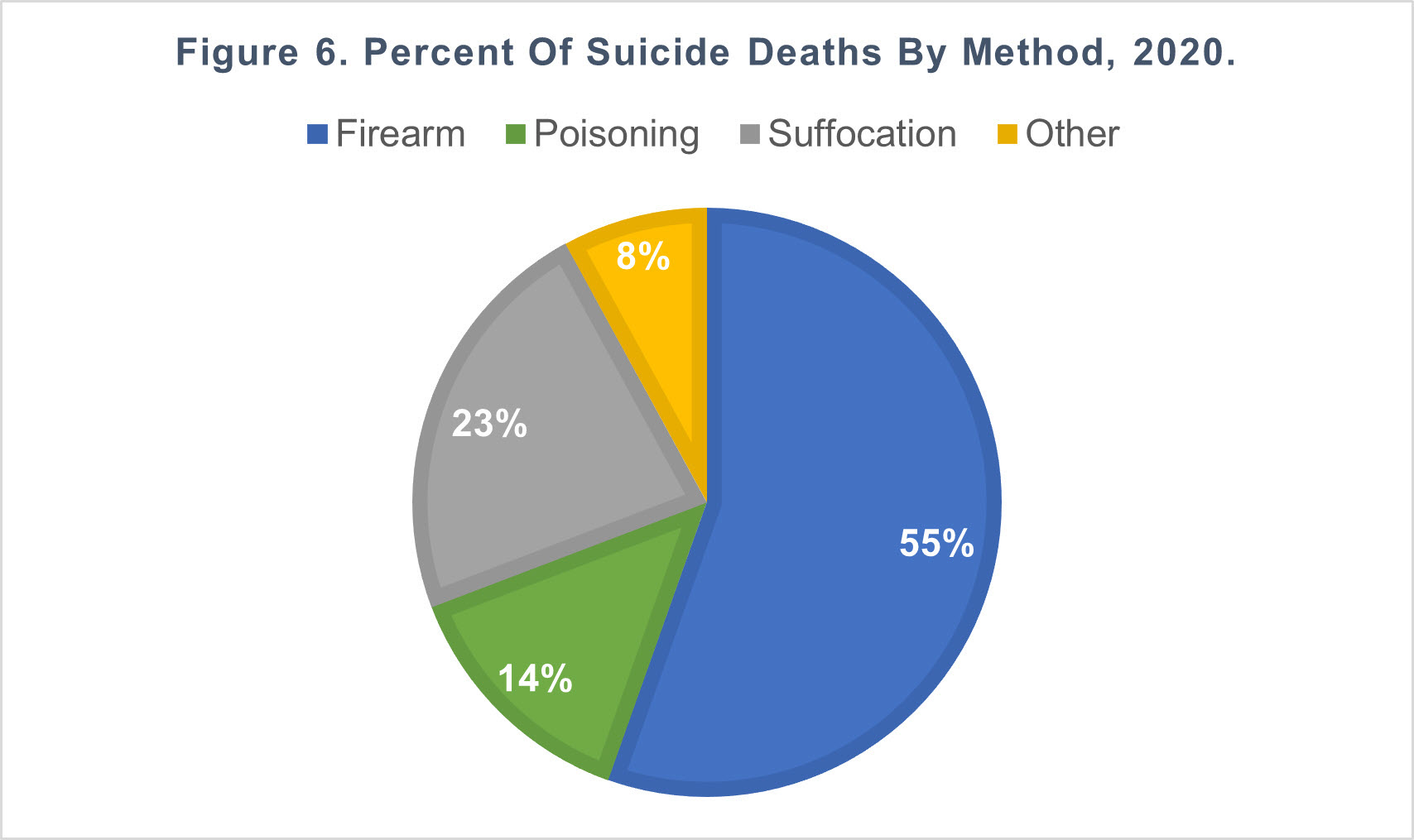
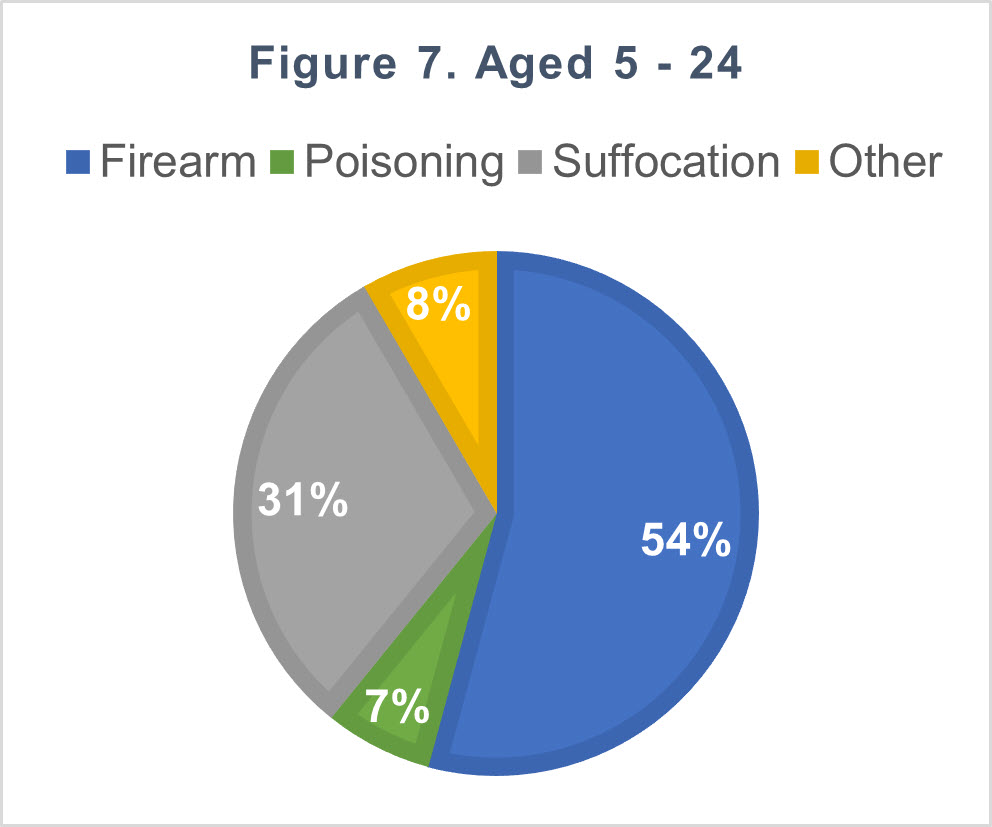
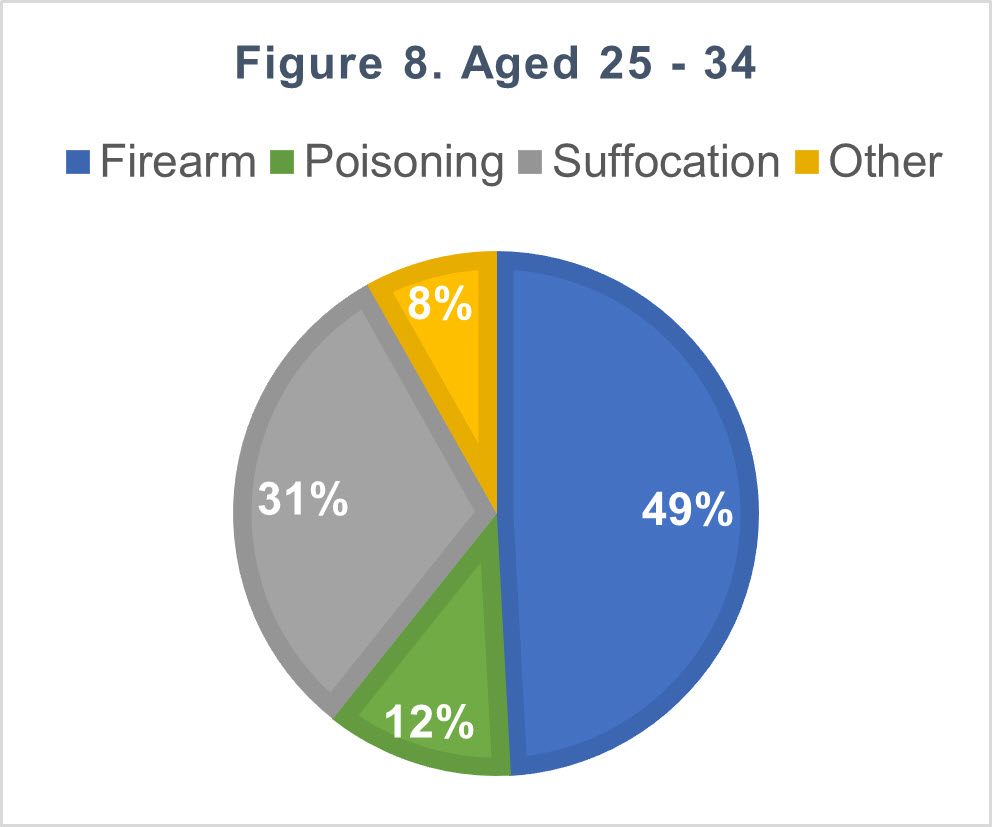
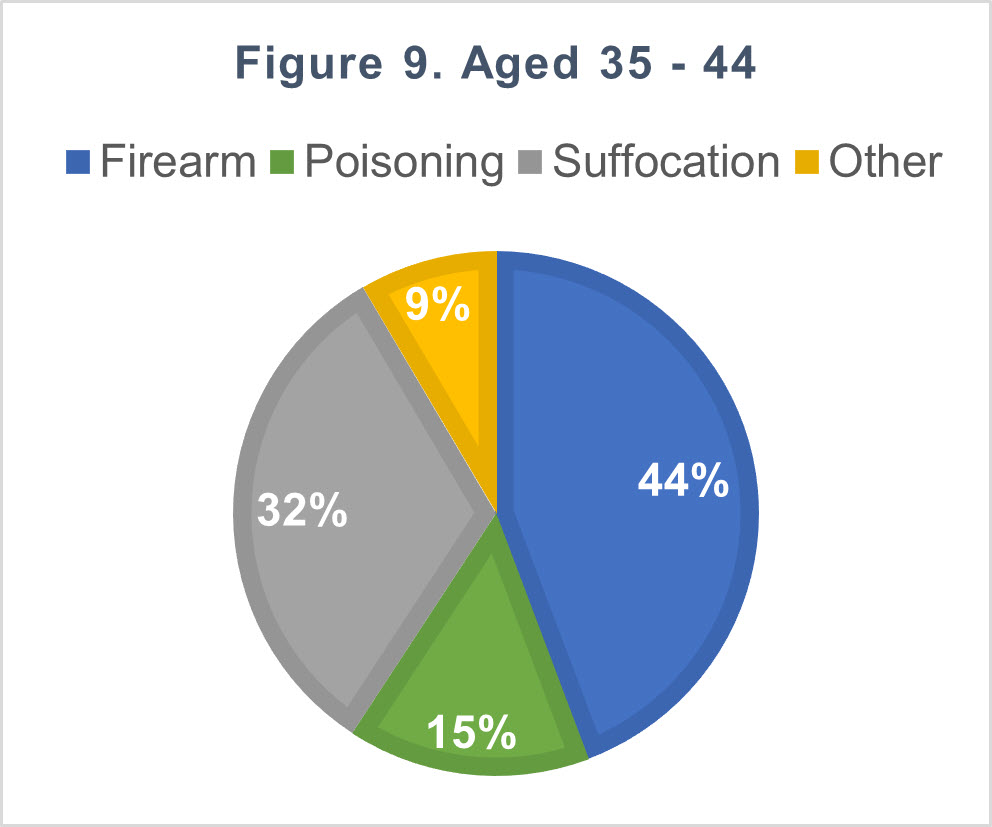
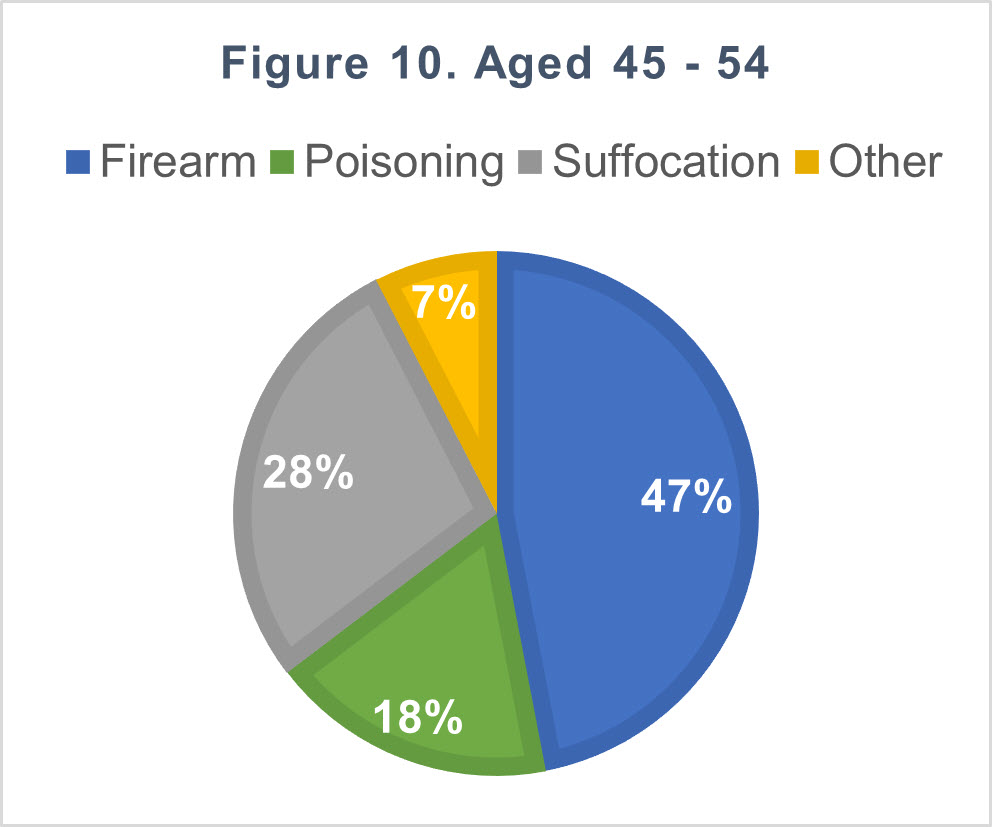
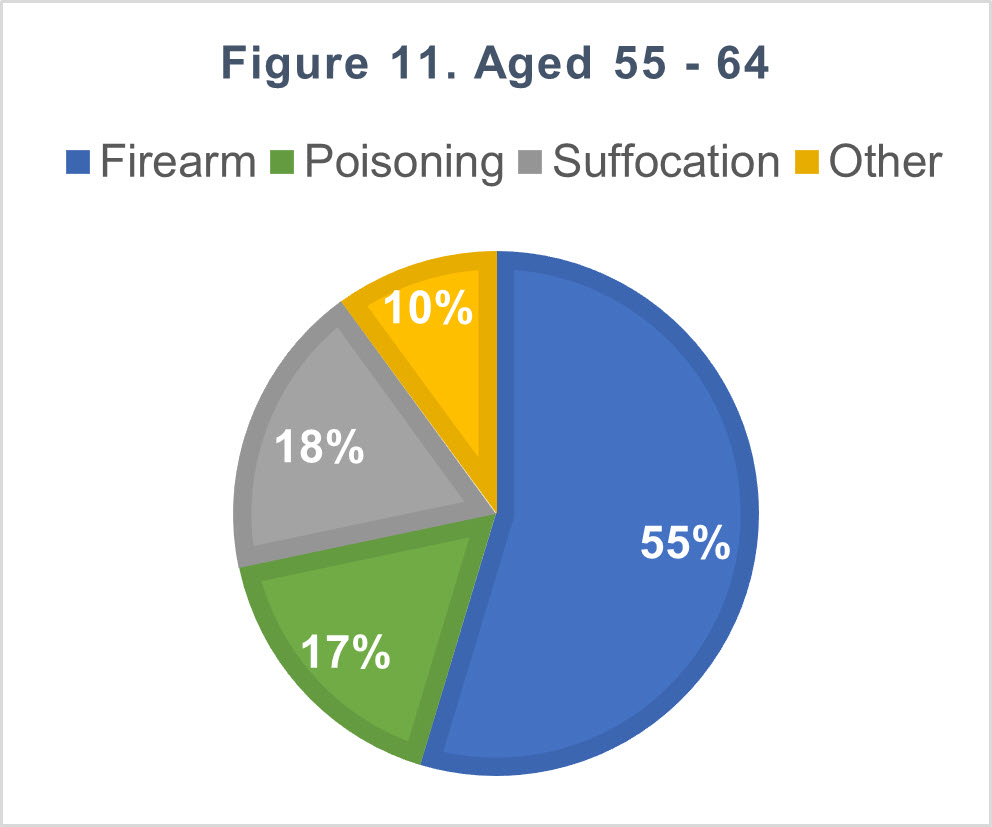
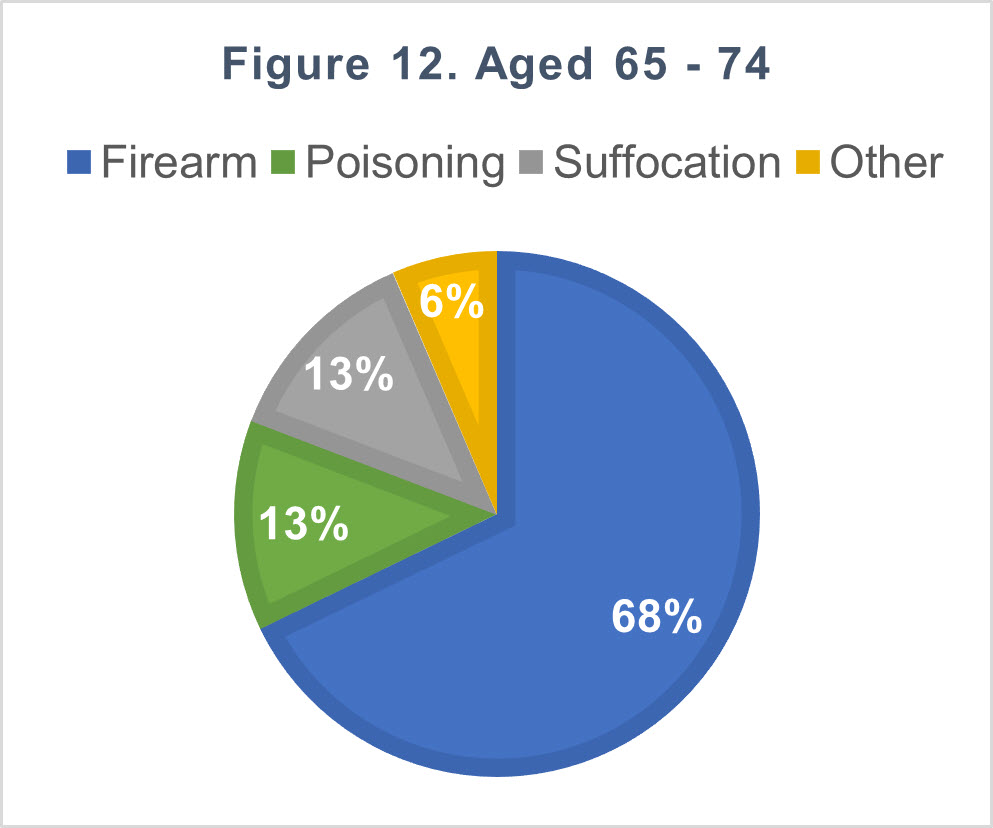
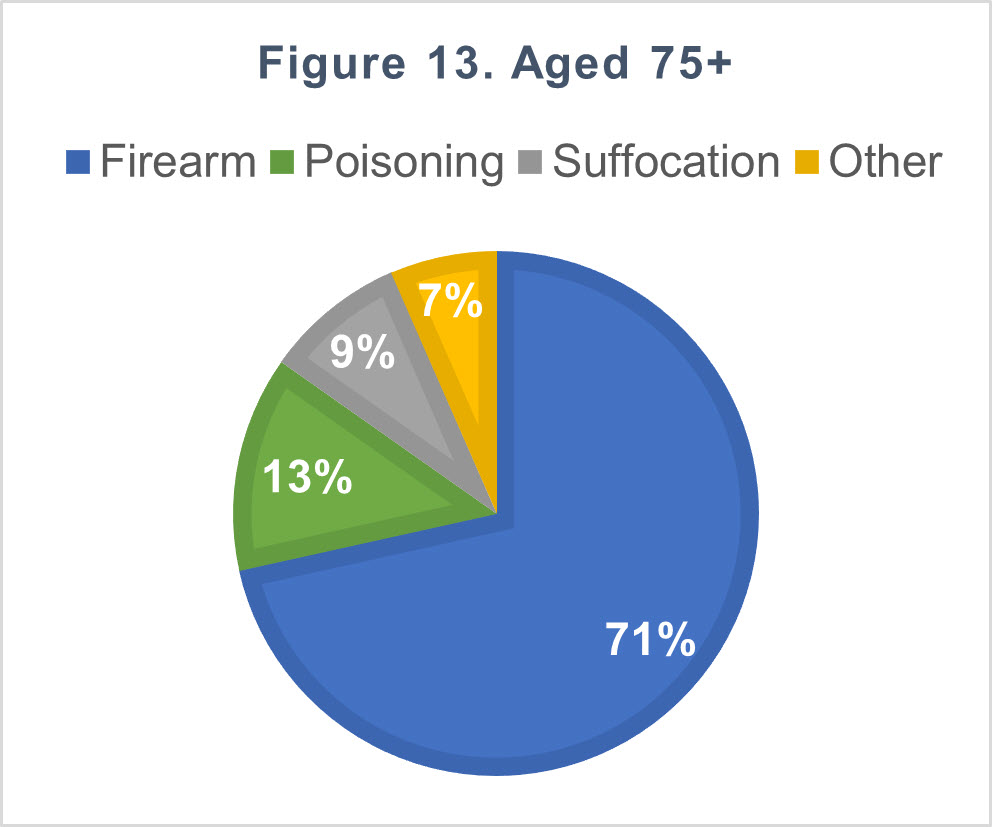
Data Sources: Florida Department of Health Bureau of Vital Statistics.
Florida Vital Statistics through FL Health Charts
All suicide-related death information is collected and housed within DOH’s Community Health Assessment Resource Tool Set, Florida Health CHARTS http://www.flhealthcharts.com/charts/default.aspx Data is provided via a publicly available dashboard, which provides indicators and county- level data for a multitude of health-related outcomes. As of July 2020, Florida Health CHARTS includes a suicide/mental health profile, which provides an overview of suicide and suicide-related data. The website includes a tutorial, directions/checklists, and offers users access to provisional 2020 and 2021 data. Provisional data is updated daily at approximately 5:00 a.m. EST until the final data is published.
Florida Youth Risk Behavior Survey
The Youth Risk Behavior Survey (YRBS) is a statewide, school-based survey of Florida’s public high school students. The YRBS is a part of the Florida Youth Survey, which includes additional surveys of youth behavior. Self-harm behaviors are captured within the YRBS for Florida high school students. For more information on the YRBS and the Florida Youth Survey, please visit Survey Data | Florida Department of Health (floridahealth.gov)
How can I help prevent suicide?
There are many ways you can help prevent suicide. First, learn the warning signs. Second connect the person displaying signs of suicide with crisis support. You can find various crisis support hotlines in the crisis support section of this website.
What are the warning signs of suicide?
Warning signs are like red flags that may indicate that a person may be more at risk for suicide.
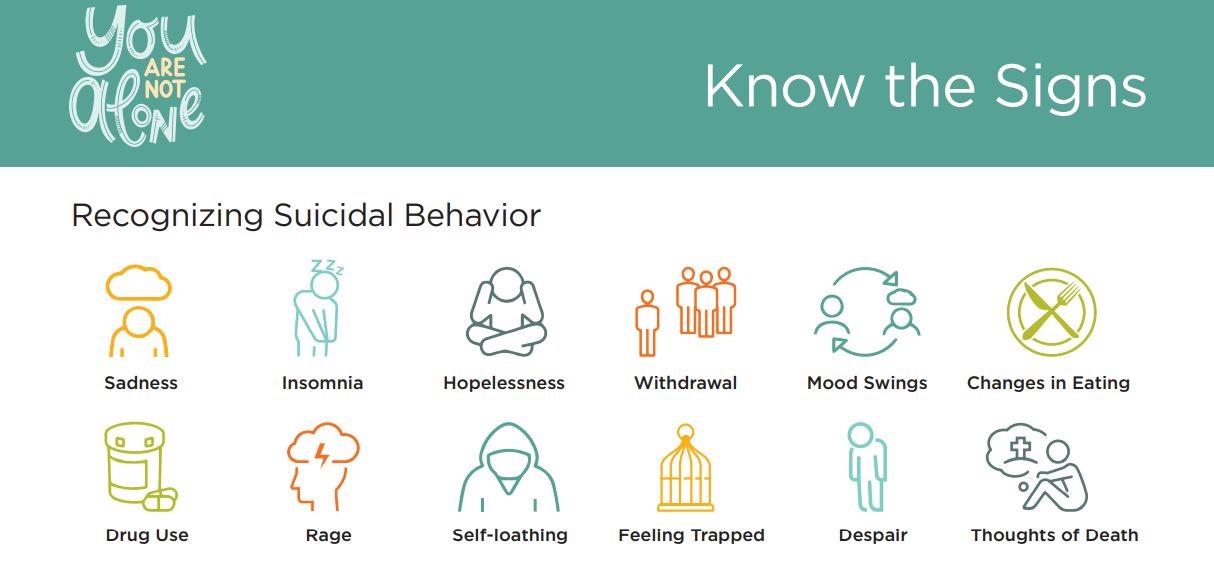
How do I know if someone is at risk for suicide?
Risks are characteristics linked with suicide and might not be the cause of it.
Risk Factors
Here is a partial list of some examples of risk factors for suicide. Risks are characteristics linked with suicide.
- Family history of suicide
- Family history of child maltreatment
- Previous suicide attempt(s)
- History of mental disorders, particularly clinical depression
- History of alcohol and substance abuse
- Feelings of hopelessness
- Impulsive or aggressive tendencies
- Isolation, a feeling of being cut off from other people
- Barriers to accessing mental health treatment
- Loss (relational, social, work, or financial)
- Physical illness
- Easy access to lethal methods
More crisis support information is also available.
Protective Factors
According to the Centers for Disease Control and Prevention, these are some protective factors for suicide. This is a partial list.
- Effective clinical care for mental, physical, and substance abuse disorders
- Easy access to a variety of clinical interventions and support for help seeking
- Family and community support (connectedness)
- Support from ongoing medical and mental health care relationships
- Skills in problem solving, conflict resolution, and nonviolent ways of handling disputes



